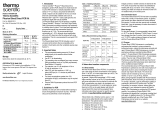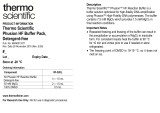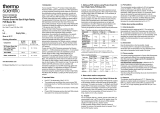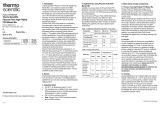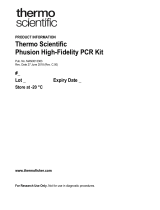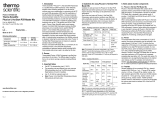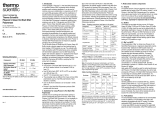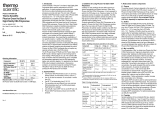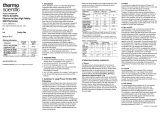Page is loading ...

PRODUCT INFORMATION
Thermo Scientific
Phusion Blood Direct PCR Master Mix
Pub. No. MAN0012900
Rev. Date 05 December 2016 (Rev. B.00)
#_
Lot: __ Expiry Date: __
Store at -20 °C
Ordering information
Component
#F-175S
100 rxns
#F-175L
500 rxns
2X Phusion Blood Direct
PCR Master Mix
1 mL
5 1 mL
50 mM EDTA (pH 8.0)
0.5 mL
0.5 mL
50 mM MgCl2 solution
1.5 mL
1.5 mL
100 % DMSO
0.5 mL
0.5 mL
Universal control primer
mix
40 µL
40 µL
Water, nuclease- free
1.25 mL
4 1.25 mL
O’GeneRuler Express DNA
Ladder
100 appl. (50 µg)
Storage
Upon arrival, store the components at -20 °C.
www.thermofisher.com
For Research Use Only. Not for use in diagnostic procedures.
1. Introduction
Thermo Scientific™ Phusion™ Blood Direct Master Mix is
designed to perform PCR directly from whole blood with no prior
DNA extraction or sample preparation. Blood stored at 4 °C or
frozen, and preserved with EDTA, citrate or heparin are all suitable
for this Master Mix, as is blood dried onto commercially available
cards such as Whatman™ 903 and FTA™ Cards. Both genomic
and exogenous target DNA can be amplified.
The Phusion Blood Direct PCR Master Mix employs a modified
Thermo Scientific™ Phusion™ Hot Start II High-Fidelity DNA
Polymerase that exhibits extremely high resistance to inhibitors
found in blood. The Master Mix has been optimized to give
excellent results from mammalian blood with amplicons up to
7.5 kb. The recommended blood concentration is 1−20 %,
although robust amplification with up to 40 % blood can often be
achieved with some optimization. This Master Mix is recommended
for end-point PCR protocols and it contains premixed gel loading
dye which allows direct sample loading on the gel. The loading
dye in the Master Mix does not interfere with PCR performance
and is compatible with downstream applications such as DNA
sequencing, ligation and restriction digestion.
The Phusion Blood Direct PCR Master Mix includes a pair of
universal control primers that are compatible with a number of
mammalian and other vertebrate species (see Section 7).
2. Important Notes
The annealing rules are different from many common DNA
polymerases (such as Taq DNA polymerases). Read Section
5.2 carefully.
The recommended starting amount is 5 % blood added
directly to the reaction without further modification.
After PCR, spin the reactions at 1 000 × g
(about 4 000 rpm) for 1−3 minutes to pellet debris from blood.
Phusion DNA Polymerases produce blunt end PCR products.
3. Guidelines for PCR
Carefully mix and spin down all tubes before opening to ensure
homogeneity and improve recovery. The PCR setup can be
performed at room temperature.
Table 1. Pipetting instructions
Component
20 µL rxn
50 µL rxn
Final conc.
2X Phusion Blood
Direct PCR Master
Mix
10 µL
25 µL
1X
Primer A
X µL
X µL
0.5 µM
Primer B
X µL
X µL
0.5 µM
Whole Blood
1 μL
2.5 μL
(See 4.1)
H2O
Add to 20 µL
add to 50 µL
Optional components for reactions optimization
50 mM MgCl2
0.6 μL
1.5 μL
(See 4.3)
50 mM EDTA
0.5-1.0 μL
1.25-2.5 μL
(See 4.3)
DMSO
1.0 μL
2.5L
5 %
(See 4.4)
Table 2. Recommended cycling protocol
Cycle step
2-step protocol
3-step protocol
Cycles
Temp.
Time
Temp.
Time
Lysis of cells
(see 5.1)
98 °C
5 min
98 °C
5 min
1
Denaturation
Annealing
(see 5.2)
Extension
(see 5.3)
98 °C
-
72 °C
1 s
-
15-30 s/kb
98 °C
X °C
72 °C
1 s
5 s
15-30 s/kb
35-40
Final Extension
72 °C
4 °C
1 min
hold
72 °C
4 °C
1 min
hold
1
Gel electrophoresis
2X Phusion Blood Direct PCR Master Mix contains a premixed
gel loading dye. After PCR samples can be directly loaded on
the electrophoresis gel for analysis.
Positive control reaction with purified DNA
When optimizing the reactions, it is recommended to perform a
positive control with purified DNA to ensure that the PCR
conditions are optimal. If the positive control with purified DNA
fails, the PCR conditions should be optimized before continuing
further.
Negative control
It is recommended to add a no-template control to all Direct PCR
assays to control contamination.
4. Notes about reaction components
4.1. Blood sample
With the Phusion Blood Direct PCR Master Mix, it is possible to
use a wide range of blood concentrations in the reaction (from
1% to 20%, or in some cases even up to 40%). The
recommended starting point is 5%.
In general, if higher blood percentage (>10%) is used, higher
reaction volume (up to 50 μL) is recommended, and some
optimization may be required (in particular the MgCl2
concentration may need to be increased up to
4.5 mM final concentration). For small amplicons, whole blood
up to 40% can be used. More information about blood volumes
for specific species available at www.thermofisher.com.
If blood dried onto a Whatman card is used, a 1 mm punch can
be added directly to the reaction without pretreatment. The
optimal reaction volume varies depending on the card type used:
Whatman 903 Card: 10−50 μL
Whatman FTA Elute Card: 25−50 μL
Whatman FTA Gene Card: 50 μL
If larger punches or smaller volumes are desired for the FTA
cards, the punches may need to be pretreated by washing with
20 μL H2O at 50 °C for 3 minutes. After washing, the water can
simply be removed and the PCR mix added directly to the rinsed
punch.
Non-mammalian blood
The Phusion Blood Direct PCR Master Mix has been
successfully tested with a variety of mammalian species. In
addition, good results have been obtained with several different
bird species. For birds and other species with nucleated blood
cells, it may be necessary to reduce the amount of blood in the
PCR reaction.
Blood storage
For long term storage, it is recommended to store blood
at −20 °C or dried on Whatman FTA/903 Cards. For short term
storage (less than 3 months), blood can be stored at 4 °C.
EDTA, sodium citrate and heparin all work well with the Phusion
Blood Direct PCR Master Mix.
4.2. Enzyme
Phusion Blood II DNA Polymerase is a proofreading polymerase
that contains a unique processivity-enhancing domain, making
this polymerase accurate and rapid. Phusion Blood II DNA
Polymerase is a hot start polymerase utilizing a reversibly
binding Affibody™ protein1,2. Phusion Blood II DNA Polymerase
possesses 5’→3’ DNA polymerase activity and 3’→5’
exonuclease activity. The error rate of Phusion Blood II DNA
Polymerase is approximately 25-fold lower than that of Thermus
aquaticus DNA polymerase when determined with a modified
lacI-based method3.
The recommended amount of Phusion Blood II DNA Polymerase
is optimized to work with most amplicons. When cloning
fragments amplified with Phusion Blood II DNA Polymerase,
blunt end cloning is recommended. If TA cloning is required, it
can be performed by adding A overhangs to the blunt PCR
product with Taq DNA Polymerase, for example. However,
before adding the overhangs it is very important to remove all
Phusion Blood II DNA Polymerase by purifying the PCR product
carefully. Any remaining Phusion Blood II DNA Polymerase will
degrade the A overhangs, creating blunt ends again. A detailed
protocol for TA cloning of PCR fragments amplified with any of
the Phusion DNA Polymerases can be found on our website:
www.thermofisher.com.
4.3. MgCl2 concentration
The 2X Phusion Blood PCR Master Mix included in the kit
provides 3.0 mM MgCl2 in the final reaction. Extensive testing
has shown 3.0 mM MgCl2 to be optimal for most PCR reactions
using whole blood. There is a separate tube of 50 mM MgCl2
(F-510MG) included in the kit for adjusting the MgCl2
concentration (up to 4.5 mM if necessary) for reactions
containing very high amounts of blood. It should be noted,
though, that excess MgCl2 may result in spurious PCR products.
If unspecific products are created with the default reaction buffer
(providing 3.0 mM MgCl2), the effective MgCl2 concentration can
be decreased by adding the chelating agent EDTA, which is
included in the kit. Typically, adding 0.5 to 1.0 μL of 50 mM
EDTA to a 20 μL reaction is sufficient to eliminate non-specific
products. Note that the optimal conditions will depend on the
primers, the percentage of blood in the reaction and/or the type
of card used, since anticoagulants and other chemicals
impregnating the cards can alter the available Mg2+
concentration.
4.4. DMSO
DMSO has been found to improve PCR results for some
amplicons (particularly GC-rich templates). With these amplicons
it is recommended to add 1−5% DMSO to the reaction. Note that
if high DMSO concentration is used, the annealing temperature
must be decreased, as DMSO alters the melting point of the
primers. It has been reported that 10% DMSO decreases the
annealing temperature by 5.5−6.0 °C4.
Other PCR additives such as formamide, glycerol, and betaine
are also compatible with Phusion Blood II DNA Polymerase.

5. Notes about cycling conditions
5.1. Lysis of cells and DNA denaturation
The initial 5-minute incubation step at 98 °C allows the lysis of
leukocytes, making genomic DNA available for PCR. The DNA
denaturation step can be very short. It is sufficient that the
reaction mixture reaches the required 98 °C.
5.2. Primer annealing
Note that the optimal annealing temperature for Phusion Blood II
DNA Polymerase may differ significantly from that of Taq-based
polymerases. Always use the Tm calculator and instructions on
our website (www.thermofisher.com/tmcalculator) to determine
the Tm values of primers and optimal annealing temperature. As
a basic rule, for primers >20 nt, anneal for 5 seconds at a
Tm +3 °C of the lower Tm primer. For primers ≤20 nt, use an
annealing temperature equal to the Tm of the lower Tm primer. If
necessary, use a temperature gradient to find the optimal
annealing temperature for each template-primer pair
combination. The annealing gradient should extend up to the
extension temperature (two-step PCR). Two-step cycling without
an annealing step is recommended for high-Tm primer pairs
(Tm at least 69−72 °C).
5.3. Extension
The extension is performed at 72 °C. The optimal extension time
varies depending on the amplicon length and the blood
concentration in the reaction. The recommended extension time
is 15 seconds for amplicons ≤1 kb, and 30 s/kb for amplicons
>1 kb. When higher blood concentrations are used, longer
extension times may improve the results.
6. Post-amplification analysis
After amplification, centrifuge the PCR reaction
at 1 000 × g for 1−3 minutes to collect the supernatant for
analysis. This step separates the various components of blood
that might interfere with subsequent assays, e.g. gel
electrophoresis. This is especially important when high blood
concentrations are used, as there can be a substantial amount
of cell debris, etc. in the tube after the PCR reaction.
If post-PCR enzyme treatment is performed (e.g. PCR-RFLP), it
may be necessary to dilute the PCR product 2−4-fold in order to
dilute the salts and other inhibitors from the PCR reaction.
7. Control reactions
7.1. Universal control primer mix
This component is a mix of degenerate primers in H2O that
amplify a 237 bp fragment of mammalian genomic DNA. The
amplified region is a highly conserved non-coding region
upstream of the SOX21 gene5, and the primers are designed to
amplify this region from a wide range of vertebrate species.
Each primer concentration is 25 μM.
Primer #1 (24-mer)
5’- AGCCCTTGGGGASTTGAATTGCTG -3’
Melting point: 73.5 °C
Primer #2 (27-mer)
5’- GCACTCCAGAGGACAGCRGTGTCAATA -3’
Melting point: 72.2°C (R=A), 75.3 °C (R=G)
Table 3. Pipetting instructions for control reactions
Component
20 µL rxn
50 µL rxn
H2O
Add to 20 µL
add to 50 µL
2X Phusion Blood Direct PCR
Master Mix
10 µL
25 µL
Universal Control Primer Mix
0.4 µL
1 μL
Whole Blood (see 4.1)
Up to 1 μL
Up to 10 μL
Table 4. Cycling instructions for control reactions
Cycle step
Temp.
Time
Cycles
Lysis of cells
98 °C
5 min
1
Denaturation
Annealing/Extension
98 °C
72 °C
1 s
15 s
35
Final Extension
72 °C
4 °C
1 min
hold
1
8. Troubleshooting
No product at all or low yield
Repeat and make sure
that there are no
pipetting errors.
Make sure that the
cycling protocol was
performed as
recommended.
Optimize annealing
temperature.
Titrate the amount of
blood in the reaction.
Increase the number of
cycles.
Check the purity and
concentration of the
primers.
Check primer design.
Increase extension time.
Increase denaturation
time up to 5 seconds.
Add 1−5 % DMSO
(especially for high GC
amplicons).
Add MgCl2 (1−2 μL/50 μL
reaction) if high blood
concentration is used.
Add EDTA
(1.25−2.5 μL/50 mL
reaction).
Non-specific products - High molecular weight smears
Make sure that the
extension time used was
not too long.
(Recommended
extension time is
15−30 s/kb).
Increase annealing
temperature or perform
a temperature gradient
PCR.
Titrate the amount of
blood in the reaction.
Reduce the total number
of cycles.
Decrease primer
concentration.
Add EDTA
(1.25−2.5 μL/50 μL
reaction).
Non-specific products - Low molecular weight discrete
bands
Increase annealing
temperature.
Titrate the amount of
blood in the reaction.
Shorten extension time.
Perform a temperature
gradient PCR.
Decrease primer
concentration.
Add EDTA
(1.25−2.5 μL/50 mL
reaction).
Design new primers.
CERTIFICATE OF ANALYSIS
Performance in PCR is tested by the amplification of 7.5 kb
fragment from human genomic DNA.
Absorption measured at 424 nm and 614 nm.
Quality authorized by: Jurgita Zilinskiene
REFERENCES
1. Nord K. et al. (1997) Nature Biotechnol. 15: 772−777.
2. Wikman M. et al. (2004) Protein Eng. Des. Sel. 17:
455−562.
3. Frey B.F. & Suppmann B. (1995) Biochemica 2: 34−35.
4. Chester N. & Marshak D.R. (1993) Analytical Biochemistry
209: 284−290.
5. Woolfe A. et al. (2005) PLoS Biology 3: 116−130.
NOTICE TO PURCHASER
Use of this product is covered by US Patent No. 6,127,155. The purchase
of this product includes a limited, non-transferable immunity from suit
under the foregoing patent claims for using only this amount of product for
the purchaser’s own internal research. No right under any other patent
claim, no right to perform any patented method and no right to perform
commercial services of any kind, including without limitation reporting the
results of purchaser's activities for a fee or other commercial
consideration, is conveyed expressly, by implication, or by estoppel. This
product is for research use only. Diagnostic uses under Roche patents
require a separate license from Roche. Further information on purchasing
licenses may be obtained by contacting outlicensi[email protected] or Out
Licensing, Life Technologies Inc., 5791 Van Allen Way, Carlsbad,
California 92008.
The purchase price of this product includes a limited, non-transferable
license under U.S. and foreign patents owned by BIO-RAD Laboratories,
Inc., to use this product. No other license under these patents is conveyed
expressly or by implication to the purchaser by the purchase of this
product.
LIMITED USE LABEL LICENSE: Internal Research and Development
Use Only.
The purchase of this product conveys to the buyer the limited, non-
exclusive, non-transferable right (without the right to resell, repackage, or
further sublicense) to use this product for internal research and
development purposes. No other license is granted to the buyer whether
expressly, by implication, by estoppel or otherwise. In particular, the
purchase of the product does not include or carry any right or license to
use, develop, or otherwise exploit this product commercially and no rights
are conveyed to the buyer to use the product or components of the
product for purposes including but not limited to provision of services to a
third party, generation of commercial databases or clinical diagnostics.
This product is sold pursuant to authorization from Thermo Fisher
Scientific and Thermo Fisher Scientific reserves all other rights. For
information on purchasing a license for uses other than internal research
and development purposes, please contact outli[email protected] or
Out Licensing, Life Technologies Inc., 5781 Van Allen Way, Carlsbad,
California 92008.
PRODUCT USE LIMITATION
This product is developed, designed and sold exclusively for research
purposes and in vitro use only. The product was not tested for use in
diagnostics or for drug development, nor is it suitable for administration to
humans or animals. Please refer to www.thermofisher.com for Material
Safety Data Sheet of the product.
© 2016 Thermo Fisher Scientific, Inc. All rights reserved. Affibody is a
registered trademark of Affibody AB, Sweden. Whatman, FTA and 903
are trademarks of GE Healthcare and its subsidiaries. All other
trademarks are the property of Thermo Fisher Scientific, Inc. and its
subsidiaries.
/
